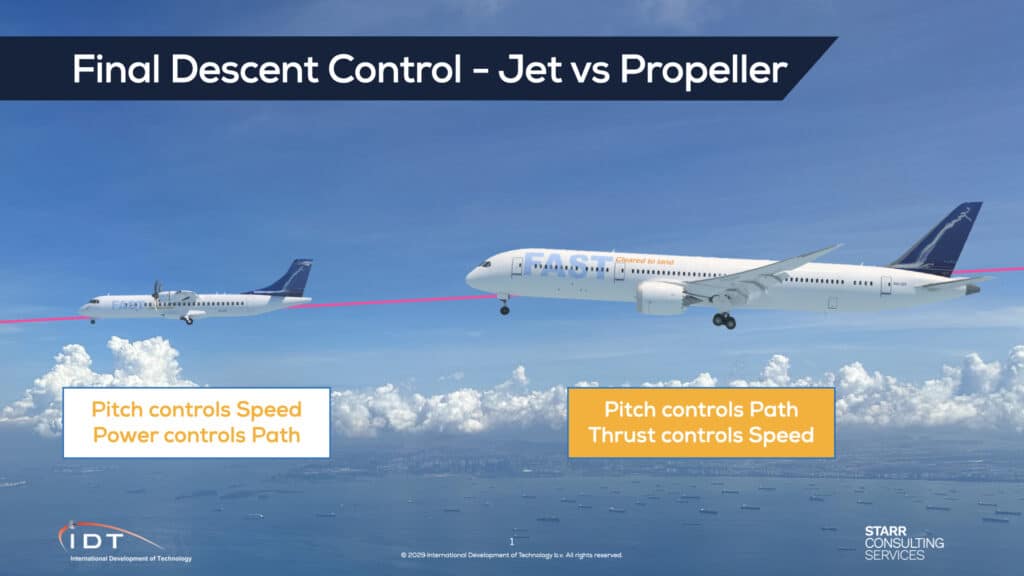Recently, IDT-SCS completed the Final Approach Standardisation Training (FAST) as well as Operator Initial UPRT at Olympic Air, the regional Greek operator of ATR and Dash-8 turboprops. IDT-SCS trained six Subject Matter Experts on these programs through both theory and practical simulator training.
This training revealed the potential importance for ALL airline instructors to understand turboprop characteristics, regardless of whether they teach on turboprops or jets. This program is also supported by IDT partner Starr Consulting Services.
The article below, written by Captain Vasileios Kloudas, Chief Pilot Turboprop Fleet, Olympic Air and Sunjoo Advani of IDT-SCS, explains this fact.
UPRT: Why should an airline instructor understand propeller airplane characteristics?
By
Captain Vasileios Kloudas, Chief Pilot Turboprop Fleet, Olympic Air, Athens, Greece
and
Dr. Sunjoo Advani, President, IDT-SCS, Breda, The Netherlands
Today’s young tech-savvy pilots have an exceptional ability to learn to fly advanced automated/augmented fly-by-wire airplanes in complex environments. With electronic learning platforms, all the sophisticated technologies and usually well-developed procedures of this age, their careers are often off to smooth start.
Yet, many a time, an airline instructor will notice certain traits in the student pilot that may seem inappropriate to handling an advanced swept-wing airliner. For example, the improper management of thrust during approach, or the application of rudder under certain occasions. While most airline training will rule these actions out, it is the task of the instructor to identify them. The instructor can in fact benefit from learning the source of these habituated characteristics. This also enables the instructor to effectively identify the required teaching points, and apply necessary building blocks (i.e. from known to unknown, from simple to complex). Apart from these obvious technical benefits, the instructor-student relationship is enhanced when instructor really tries to understand the student.
Unfortunately, there is a peculiar disparity that might prevent an airline simulator instructor to allow undesired habits to go by unnoticed. Here is the reason: Basic skills are primarily taught in a flying school, on straight-wing airplanes that require very different control manipulation and strategies than airliners. Also, the airline instructor is not necessarily taught how to detect these habits – they are often selected based on stature rather than a tenacity for teaching. Moreover the, constantly increasing number of syllabus items can put pressure to even the most seasoned airline instructor.
A different and unique set of problems emerges also when experienced pilots have to transition between different aircraft types, and especially so when they have to transition from jets to turboprops, or vice-versa. These can lead to dangerous shortcomings when the trainee is behind the controls of a high-performance airliner and has not gained the required handling skills. Fortunately, automation usually works well as a saviour. However, in rare situations, when the pilot’s skills are put to the test, the traits learned in basic flying should not lead to a worsening of the situation.
For this reason, the thorough training of instructors on basic flying skills is a must – not just for themselves, but for them to be able to detect possible deficiencies in their trainees, and to build a more thorough understanding of them.
Upset Prevention and Recovery Training, when conducted properly, not only reveals the true nature of the airplane under a wide range of flight conditions – it also provides the instructor the tools to detect trainee habits, which may have been engrained during prior training, whether it be in flying school, or turboprop operations in a subsidiary airline, or other. UPRT contributes also indirectly as a necessary building block for monitoring skills as well as a pre-requisite for a more thorough understanding of commonly-practiced airline syllabus items: wind shear recovery, unreliable airspeed, GPWS recovery procedures are some examples.
Finally, UPRT is also an instructor’s own opportunity for redemption – providing tools to build the final, critical safety net, any time, anywhere, since UPRT in itself is an opportunity to create a better airline instructor.

